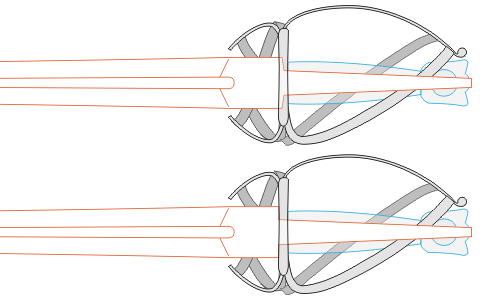| Author |
Message |
Jasper B.

|
 Posted: Sun 12 Apr, 2015 6:25 am Post subject: Tang and pommel attachement method of schiavona? Posted: Sun 12 Apr, 2015 6:25 am Post subject: Tang and pommel attachement method of schiavona? |
 |
|
Hi,
I was wondering how the tang looked for a Schiavona? I've been looking at lots of images of both antiques and replicas, but it is hard to see this part because it is hidden by the crossbar, handle and pommel.

Figure 1. Two possible options for the tang's shoulder.
In older swords, the shoulder of the tang typically seems to be embedded somewhat into the cross guard. Is this also typically the case with schiavonas? or is the cross guard put against the shoulder of the tang?
Also, how is the pommel attached? I would guess the tang is not threaded, but I can't seen any peened end either? What attachment method is typically used?
Edit:
If it makes a difference, I'm mostly interested in Type II / Type IIa schiavonas in this case.
Regards,
J.B.
 Attachment: 43.43 KB Attachment: 43.43 KB

Two possible options for the tang's shoulder.
|
|
  |
 |
|
Andrew Gill
|
 Posted: Mon 13 Apr, 2015 1:23 am Post subject: Posted: Mon 13 Apr, 2015 1:23 am Post subject: |
 |
|
I'm not an expert, so take the following with a pinch of salt:
I think that by the time that schiavonas were popular, sword production was quite specialised; most sword blades would be almost mass-produced and supplied to craftsmen responsible to creating the hilt. If you look at surviving examples of shiavonas, you can see quite a wide variety of blades on them: broad or narrow double edged blades with varying numbers of fullers (I think I've even seen one with no fullers) and even some with backsword blades - it is the hilt and pomel which are distinctive and identify the type. So the tangs would probably be just like other broadsword blades, because that is what they are (and if the blade, hilt and pommel all part company, there probably wouldn't be a way to be sure that it was specifically a schiavona,
and it is possible that examples of both sorts exist.
Having said all that, from a (modern) structural point of view, the embedded shoulder is much stronger, and as you say, it was used in older swords and therefore known, so it was probably what was done. The only reason I can think of offhand to not do so is to save time and effort for bottom-end munitions-grade weapons, and given the cheapness of labour at the time, this might not have been a good enough reason to do so.
|
|
  |
 |
Craig Johnson
Industry Professional

|
 Posted: Mon 13 Apr, 2015 5:51 am Post subject: no simple answer Posted: Mon 13 Apr, 2015 5:51 am Post subject: no simple answer |
 |
|
Hi Jasper
I have seen both shoulder transitions to the hilt. The deeply embedded version being probably the version found the least. The majority I would say would be between your two examples. Often being set in a shallow grove more than a blade shaped inset into the guard. This is one of the details often misunderstood today that the inset into a guard for a blade to seat into is quite variable in the historical record.
The deeply inset super tight fitting blade shaped recepticle is not often seen on most swords. There are examples to be sure but the reality of how it was done can be seen to vary greatly from sword to sword and across time. They could be just as easily shallow more open shapes to a ground grove to a hollow the recieves the blade and is filled with a mastic of some form.
In Schiavona I think the shallow grove is probably the most common.
Pommels are peened in most cases. If my memory serves I think I have seen a horizontally pinned example as well but this may well have been a quite late version. The dimension that most folks miss on the pommel is the thickness. They are often very thin and many will be thinner than the grip making for a strange transition to our eye today.
The other element to remember when looking at these swords is many have had blade changes over their lifespan. In the context of the antiquities market it maybe rare to find a piece today for sale that is as it was assembled originally in the past.
Best
Craig
|
|
    |
 |
|
|
You cannot post new topics in this forum
You cannot reply to topics in this forum
You cannot edit your posts in this forum
You cannot delete your posts in this forum
You cannot vote in polls in this forum
You cannot attach files in this forum
You can download files in this forum
|
All contents © Copyright 2003-2025 myArmoury.com — All rights reserved
Discussion forums powered by phpBB © The phpBB Group
Switch to the Basic Low-bandwidth Version of the forum
|

